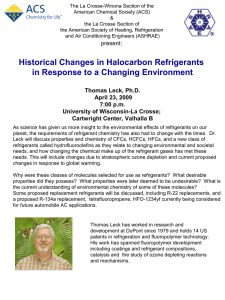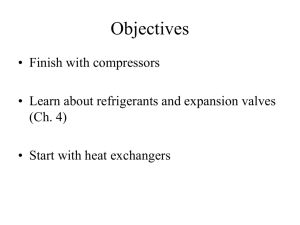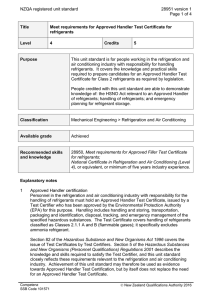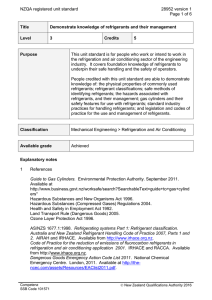NZQA registered unit standard 28950 version 1 Page 1 of 5
advertisement
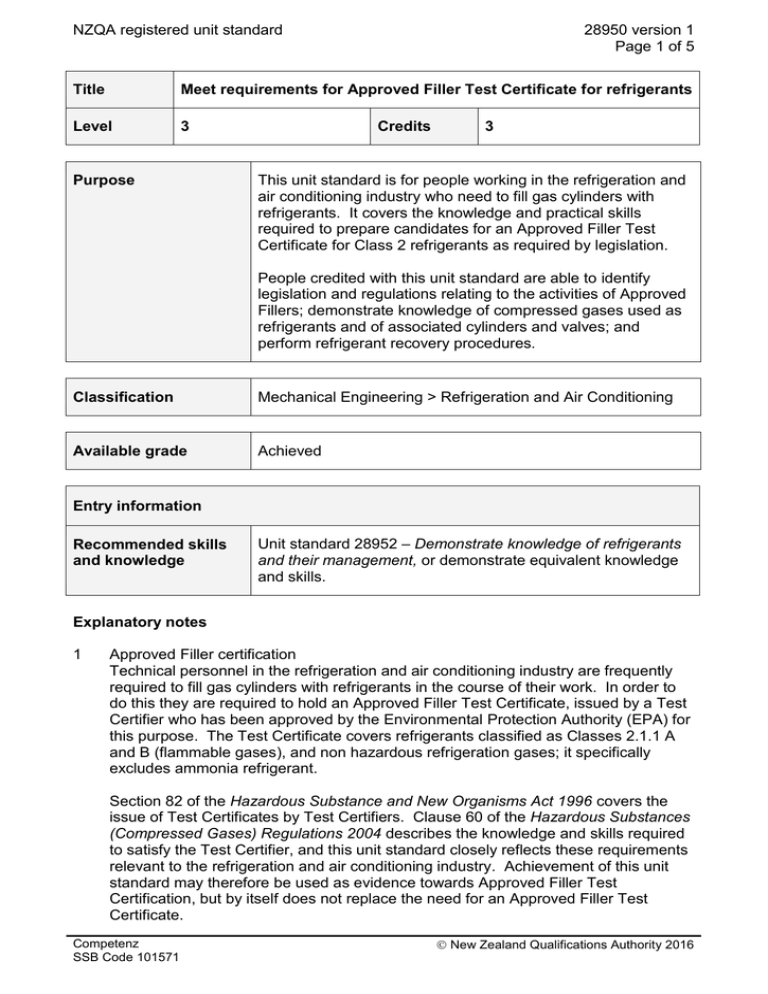
NZQA registered unit standard 28950 version 1 Page 1 of 5 Title Meet requirements for Approved Filler Test Certificate for refrigerants Level 3 Purpose Credits 3 This unit standard is for people working in the refrigeration and air conditioning industry who need to fill gas cylinders with refrigerants. It covers the knowledge and practical skills required to prepare candidates for an Approved Filler Test Certificate for Class 2 refrigerants as required by legislation. People credited with this unit standard are able to identify legislation and regulations relating to the activities of Approved Fillers; demonstrate knowledge of compressed gases used as refrigerants and of associated cylinders and valves; and perform refrigerant recovery procedures. Classification Mechanical Engineering > Refrigeration and Air Conditioning Available grade Achieved Entry information Recommended skills and knowledge Unit standard 28952 – Demonstrate knowledge of refrigerants and their management, or demonstrate equivalent knowledge and skills. Explanatory notes 1 Approved Filler certification Technical personnel in the refrigeration and air conditioning industry are frequently required to fill gas cylinders with refrigerants in the course of their work. In order to do this they are required to hold an Approved Filler Test Certificate, issued by a Test Certifier who has been approved by the Environmental Protection Authority (EPA) for this purpose. The Test Certificate covers refrigerants classified as Classes 2.1.1 A and B (flammable gases), and non hazardous refrigeration gases; it specifically excludes ammonia refrigerant. Section 82 of the Hazardous Substance and New Organisms Act 1996 covers the issue of Test Certificates by Test Certifiers. Clause 60 of the Hazardous Substances (Compressed Gases) Regulations 2004 describes the knowledge and skills required to satisfy the Test Certifier, and this unit standard closely reflects these requirements relevant to the refrigeration and air conditioning industry. Achievement of this unit standard may therefore be used as evidence towards Approved Filler Test Certification, but by itself does not replace the need for an Approved Filler Test Certificate. Competenz SSB Code 101571 New Zealand Qualifications Authority 2016 NZQA registered unit standard 2 28950 version 1 Page 2 of 5 References EPA 0073. Guide to Gas Cylinders. Environmental Protection Authority. October 2013. Available from http://www.business.govt.nz/worksafe/notifications-forms/hsnoactivities-certification-qualifications-licensing/certification-of-equipment-plantsbuildings/gas-cylinders-fire-extinguishers Hazardous Substances and New Organisms Act 1996. Hazardous Substances (Compressed Gases) Regulations 2004. Health and Safety in Employment Act 1992. Land Transport Rule: Dangerous Goods 2005. Land Transport Rule: Dangerous Goods Amendment 2010. Ozone Layer Protection Act 1996. AS 2030.1:2009, Gas cylinders Part 1: General requirements. AS/NZS 1677.2:1998, Refrigerating systems Part 2 – Safety requirements for fixed applications. Australia and New Zealand Refrigerant Handling Code of Practice 2007, Parts 1 and 2. AIRAH and IRHACE. Available from www.irhace.org.nz. Code of Practice for the reduction of emissions of fluorocarbon refrigerants in refrigeration and air conditioning application 2001. IRHACE and RACCA. Available from http://www.irhace.org.nz Safety Data Sheets (for refrigerants). Available from refrigerant suppliers, and must be available on the work site. 3 Definitions AIRAH – Australian Institute of Refrigeration and Air Conditioning and Heating. Approved Filler – a person who has been approved by a test certifier to fill specified compressed gases into gas cylinders, e.g. refrigerant gases. CCCA – Climate Control Companies Association. EPA – Environmental Protection Authority of New Zealand. Filling – the activities of an Approved Filler of specified gases. HSNO – Hazardous Substance and New Organisms Act 1996. IRHACE – Institute of Refrigeration, Heating and Air Conditioning Engineers New Zealand. Test Certifier – a person who has been authorised by the EPA to certify that the requirements of the HSNO Act have been met. 4 Assessment a A current Approved Filler Test Certificate may be used as evidence for this unit standard. b Assessment of all elements is ‘open book’. Outcomes and evidence requirements Outcome 1 Identify legislation and regulations relating to the activities of Approved Fillers. 1.1 Legislation and regulations relating to the activities of Approved Fillers are identified. Competenz SSB Code 101571 New Zealand Qualifications Authority 2016 NZQA registered unit standard Range 28950 version 1 Page 3 of 5 prevention of adverse effects of hazardous substances; transport of dangerous goods; compliance issues relevant to compressed gases including requirements for Approved Fillers; responsibilities for health and safety; release of refrigerant gases into the atmosphere. Outcome 2 Demonstrate knowledge of compressed gases used as refrigerants. Evidence requirements 2.1 The term refrigerant is defined with reference to heat. 2.2 The term liquefied gas is explained with reference to temperature and pressure. 2.3 The different forms of refrigerant gases are defined in terms of temperature. Range low pressure liquefied gas, high pressure liquefied gas, permanent gas, cryogenic gas. 2.4 The adverse effects of compressed refrigerant gases in relation to environment and health are described in accordance with Safety Data Sheets and AS/NZS 1677.2:1998. 2.5 Personal Protective Equipment required for refrigerant filling operations is identified in accordance with Safety Data Sheets. 2.6 Information relevant to filling operations is extracted and interpreted from Safety Data Sheets for given refrigerants. Outcome 3 Demonstrate knowledge of cylinders and valves used for refrigerants. Range Hazardous Substances (Compressed Gases) Regulations 2004; Guide to Gas Cylinders. Evidence requirements 3.1 The factors that can trigger cylinder failure are identified. 3.2 Given a cylinder’s approval number and design standard, the refrigerant(s) with which it may be filled is/are identified. 3.3 Terms relating to the filling of cylinders are defined. Range Competenz SSB Code 101571 terms – tare weight, empty weight, ullage, fill ratio, water capacity, working pressure, test pressure. New Zealand Qualifications Authority 2016 NZQA registered unit standard 28950 version 1 Page 4 of 5 3.4 The periodic testing and inspection intervals for cylinders are identified, given the cylinder’s purpose and age. 3.5 Over-pressure safety devices are identified. 3.6 Given cylinder and valve markings are interpreted. 3.7 The purpose of left and right hand threads on valve outlets is explained with reference to flammable and non-flammable gases. 3.8 The items to be checked in a visual inspection of a gas cylinder are identified. 3.9 Parameters relating to a given filling scenario are calculated parameters – amount of residual refrigerant; maximum charge; maximum fill weight; refrigerant weight that may safely be recovered. Range Outcome 4 Perform refrigerant recovery procedures. Range in accordance with Australia and New Zealand Refrigerant Handling Code of Practice 2007; AS/NZS 1677.2:1998; instructions for refrigerant recovery equipment. Evidence requirements 4.1 Pre-recovery procedure is carried out. 4.2 Recovery procedures are carried out. recovery procedures – liquid, vapour, push-pull. Range 4.3 Post-filling tasks are carried out. Range leak check; final weight does not exceed calculated maximum filled weight; cylinder labelled with refrigerant recovered. Planned review date 31 December 2020 Status information and last date for assessment for superseded versions Process Version Date Last Date for Assessment Registration 1 18 June 2015 N/A Consent and Moderation Requirements (CMR) reference 0013 This CMR can be accessed at http://www.nzqa.govt.nz/framework/search/index.do. Competenz SSB Code 101571 New Zealand Qualifications Authority 2016 NZQA registered unit standard 28950 version 1 Page 5 of 5 Please note Providers must be granted consent to assess against standards (accredited) by NZQA, before they can report credits from assessment against unit standards or deliver courses of study leading to that assessment. Industry Training Organisations must be granted consent to assess against standards by NZQA before they can register credits from assessment against unit standards. Providers and Industry Training Organisations, which have been granted consent and which are assessing against unit standards must engage with the moderation system that applies to those standards. Requirements for consent to assess and an outline of the moderation system that applies to this standard are outlined in the Consent and Moderation Requirements (CMRs). The CMR also includes useful information about special requirements for organisations wishing to develop education and training programmes, such as minimum qualifications for tutors and assessors, and special resource requirements. Comments on this unit standard Please contact Competenz at qualifications@competenz.org.nz if you wish to suggest changes to the content of this unit standard. Competenz SSB Code 101571 New Zealand Qualifications Authority 2016
